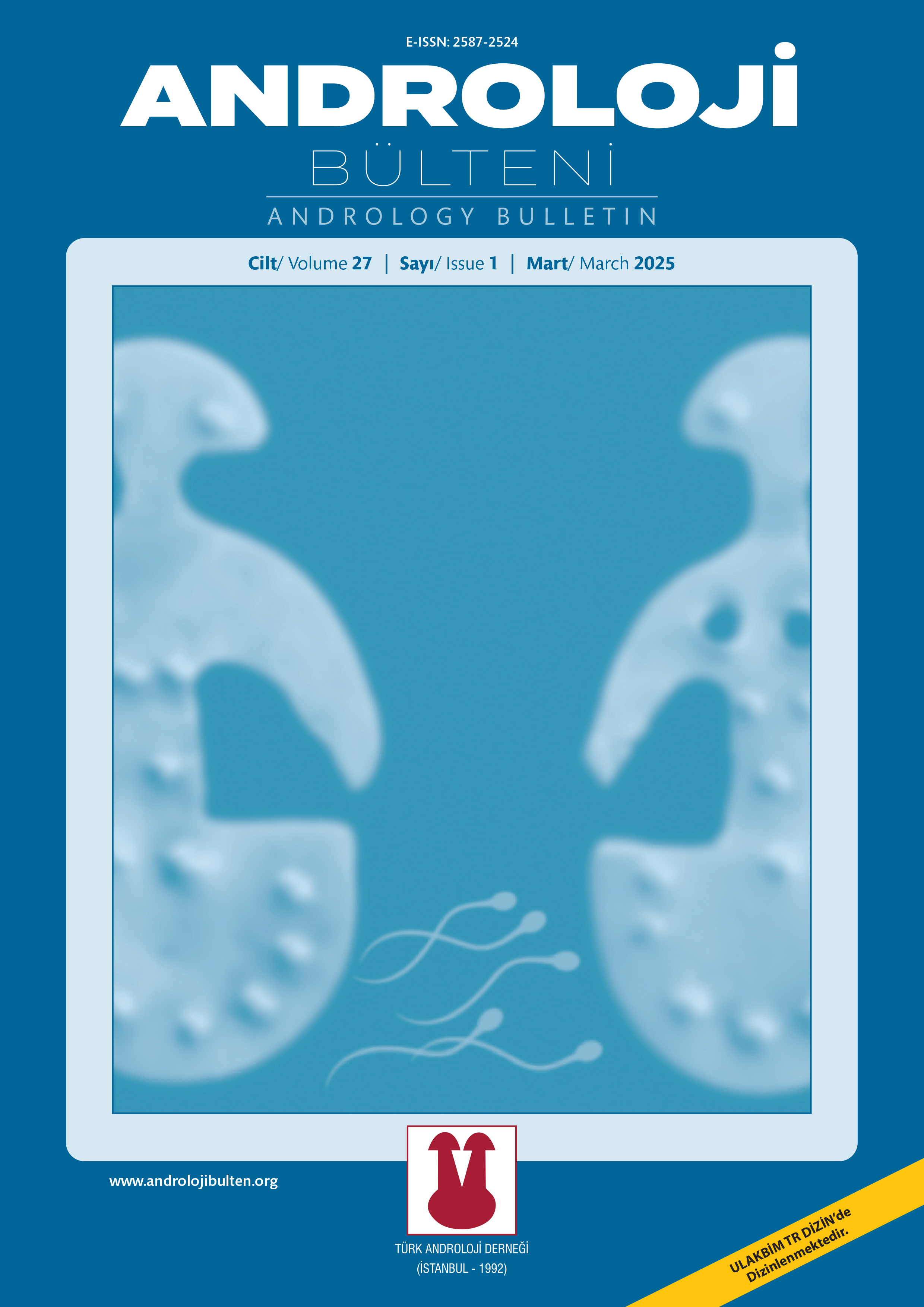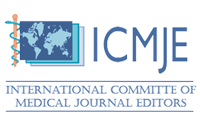INDEXES

Content of this journal is licensed under a Creative Commons Attribution-NonCommercial 4.0 International License.
Volume: 19 Issue: 1 - 2017
| 1. | Cover Pages I - II |
| 2. | Reviewers Pages III - IV |
| MESSAGE FROM PRESIDENT | |
| 3. | From The President Page V |
| EDITOR'S CORNER | |
| 4. | From The Editor Page VI |
| INDEX | |
| 5. | Contents Page VII |
| 6. | Congress Announcement Page VIII |
| CLINICAL ORIGINAL ARTICLE | |
| 7. | A new suprapubic incision technique for reconstruction of the adult buried penis Hasan Yılmaz, Murat Üstüner, Mustafa Yüksekkaya, Mehmet Esat Kösem, Ali Kemal Uslubaş, Mustafa Melih Çulha doi: 10.24898/tandro.2017.26214 Pages 1 - 5 INTRODUCTION: We present a novel suprapubic incision technique to obtain amore esthetical and longer penis appearance in adult patients with complaining buried penis. METHODS: We retrospectively evaluated medical records of 19 patients who underwent reconstruction of adult buried penis in our clinic between 2013 and 2016. All procedures began with a 8 cm transvers downward crescent incision 2 cm above the penoscrotal junction. After removing all adipose tissue among skin, rectus fascia, and penile root (suprapubic lipectomy), the lateral tips of the incision are fixed in the midline from their subdermis to rectus fascia. Thus, the transvers incision is broughtto vertical plan. The tips of the new vertical incision are extracted like an open triangle to obtain a more esthetical wound suturation. After suturation, a ventral “Z plasty” incision is applied to penoscrotal junction to prevent the dorsal growing penile length. RESULTS: The median patient age was 31 (20–67). As regarding the weight of the patients, five had normal weight, nine patients were over weight, five patients were obese. None of the patients had morbide obesity. The median body mass index was 24.7 (21.8–34.2) kg/m2. The mean operation time was 65±25 min. The median increase in penile length was 2.3(1.3–3.6) cm (p <0.05). Postoperative wound infection occured in four patients (Clavien Grade 1). DISCUSSION AND CONCLUSION: The current incision technique is a simple, safe and successful procedure with minor complications, and obtains an acceptable and significant increase in penile length. |
| 8. | Treatment of Peyronie’s Disease in mild to moderate penile curvature with plication and grafting surgery Ahmet Tahra, Eyüp Veli Küçük, Abdurrahman İnkaya doi: 10.24898/tandro.2017.46547 Pages 6 - 9 INTRODUCTION: It was aimed to compare penile plication and graft methods in patients with mild to moderate curvature (30–75°) in Peyronie’s disease (PD). METHODS: All patients with PD and operated between 2010–2016 were retrospectively reviewed. Patients with 30 to 75 degrees of curvature were included in the study as a group of plication (n=19) and another group of grafting surgery (n=16). Patients with complex curvatures, hourglass deformities, ‘hinge’ effect appearance, and patients with penile prosthesis implantation due to erection problems were excluded from study. Penile length measurements were taken preoperatively and postoperatively at 3 months, 6 months, and 12 months, and erectile status was assessed using the IIEF-5 questionnaire. Success was assessed as being 15 degrees and less curvature, and establishing relationships without any additional treatment. RESULTS: The mean age of the patients was 52.6 ± 5.4. Age and comorbidity were similar in both groups. The mean degree of penile curvature was 45.2 ± 12.3 degrees in the plication group and 50.6 ± 20.1 degrees in the graft group. Recurrent curvature was observed in 3 patients (15.7%) in the plication group, whereas on the average 2.1 ± 0.9 cm shortening was observed in penile length of the patients. The mean increase in the IEFF-5 form was 3.4 ± 1.3. In the grafting group, 93.7% of the patients were satisfied with the operation, while the number of patients with whom they were able to establish a relationship without any treatment was 13 (81.2%). Recurrent curvature was present in 2 (12.5%) of the patients. The mean increase in the IEFF-5 form was 3.1±1.8. Recurrence was similar in both groups. Mean IIEF-5 score increase was similar in both groups (p=0.8). DISCUSSION AND CONCLUSION: In patients with mild to moderate curvature, plication therapy and grafting surgery are effective and safe treatments in appropriately selected patients with Peyronie’s disease. |
| 9. | Congenital penile curvature results using penile plication technique Fuat Kızılay, Mehmet Şahin, Barış Altay doi: 10.24898/tandro.2017.03779 Pages 10 - 15 INTRODUCTION: Penile plication technique is a fundamental technique used in the treatment of congenital penile curvature disease. We aimed to analyze the success rate and results of this technique in our patients. METHODS: We performed retrospective analysis of 50 patients who underwent penile plication. We reached the patients via telephone and called them for control. Patients’ overall satisfaction associated with the procedure, complication rate, hospitalization time, the degree of curvature, erectile function and feeling of palpable lesion were questioned. RESULTS: The mean age of the cases was 29.75 (22–48). The mean curvature degree was 40.1. Ventral was the most common curvature direction. The most common curvature degree was 45°. Forty patients (80%) were discharged on the first postoperative day. There was feeling of palpable lesion in 10 patients (20%). Thirty-six patients (% 72) declared that they were generally satisfied with the procedure. Minor complications were seen in 6 patients, none required intervention. Residual 5° curvature was detected in 10 patients (20%), but no secondary surgery was required. Four patients reported feeling of palpable lesion (8%) and 3 patients had penile numbness (6%). Fortyfour patients (88%) reported no deterioration in erectile function. DISCUSSION AND CONCLUSION: Plication technique is a frequently performed method in the treatment of congenital penile curvature with a low complication rate and high patient satisfaction. Urologists must pay attention to patients’ expectations from the surgery during the preoperative period and patients must be avoided from having impossible expectations. The use of polyester sutures has reduced the feeling of palpable lesion. |
| REVIEW | |
| 10. | The impact of working life on men’s reproductive health Yasemin Hamlacı, Burcu Yılmaz, Nebahat Özerdoğan doi: 10.24898/tandro.2017.91885 Pages 16 - 21 The reproductive health which is affected by many factors such as lifestyle and nutrition is also highly affected by the working life which covers a large part of life. It is mostly men who are working in hazardous fields with physical and chemical factors. Technical developments led to new developments in industry, the increase of fields working with chemicals, and to the negative impacts on environmental factors. Men are forced to work anywhere under the burden of economic gain; to earn a living and meeting the financial needs of the family are a great social pressure on men. The reproductive health and ability of a man who faces various risks during his working life should be considered as a further pressure factor. However, despite all these, the effects of working life on the reproductive health of men is ignored. On this basis, the main axis of this review is to get information about the occupational risks on the reproductive health of the men. |
| 11. | Efficacy of tadalafil 5 mg in the treatment of benign prostatic hyperplasiarelated lower urinary tract symptoms Ali Atan doi: 10.24898/tandro.2017.48303 Pages 22 - 24 In the treatment of BPH-related lower urinary tract symptoms, tadalafil 5 mg is of the medical treatment options that have been used clinically in recent years. In this review, introduction to clinical use and efficacy of tadalafil 5 mg for BPH/LUTS is described. |
| 12. | The importance of testosterone in treatment of sexual dysfunction in postmenopausal women: a review of literature Cem Yücel, Mehmet Zeynel Keskin, Özgür Çakmak, Zafer Kozacıoğlu doi: 10.24898/tandro.2017.69926 Pages 25 - 28 Female sexual dysfunction is a problem associated with many causes affecting 38–63% of women. Alteration of hormonal balance with menopause causes female sexual dysfunction. Testosterone and estrogen levels decrease in the postmenopausal period. Menopause-induced androgen insufficiency may lead to chronic fatigue, depression, decreased libido and sexual dysfunction independent of estrogen deprivation. Many studies have reported that use of testosterone in postmenopausal women positively affects sexual desire, sexual arousal, vaginal blood flow, orgasm frequency and sexual satisfaction. The current data shows that androgens play an important role in female sexual functions. It is shown that transdermal testosterone may be effective in the treatment of postmenopausal women with sexual dysfunction. Currently, no hormone preparation such as testosterone or estrogen-testosterone has been approved in the treatment of postmenopausal sexual dysfunction. In this review, the importance of postmenopausal use of testosterone hormone in sexual dysfunction treatment has been discussed with the guide of current literature |
| PUBLICATIONS AND CONGRESS CALENDAR OF ANDROLOGY | |
| 13. | Andrology Publications In Turkey Pages 29 - 31 Abstract | |













